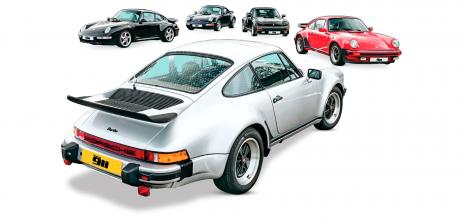Driven: every air-cooled Porsche 911 Turbo, from 930 3.0 to 993 X50
From 930 to 993, Total 911 charts the evolution of Porsche’s air-cooled Turbo. Written by Tim Pitt Photography by Ali Cusick.
Driven: every air-cooled Porsche 911 Turbo, from 930 3.0 to 993 X50. Which is best?
Best of the Classic Turbo
DRIVEN: EVERY AIR-COOLED TURBO, FROM 930 3.0 TO 993 X50. WHICH IS BEST?
Andreas Preuninger often reminisces about the white and blue Carrera 2.7 RS that occupied his bedroom wall. For me, being a few years younger than the head of Porsche’s GT division, pride of place went to a red 930 Turbo. To a car-obsessed kid in Croydon, the flagship 911 seemed impossibly exotic. In many respects, the 930 was the yang to Andreas’ yin. It traded lightweight for luxury, unambiguous focus for a split personality, and linear throttle response for bludgeoning boost. It also had huge haunches instead of slim hips, while delicate chrome gave way to bulbous black plastic. The Turbo was more at home on an autobahn than at a racetrack. Many Porsche purists were miffed. I loved it.
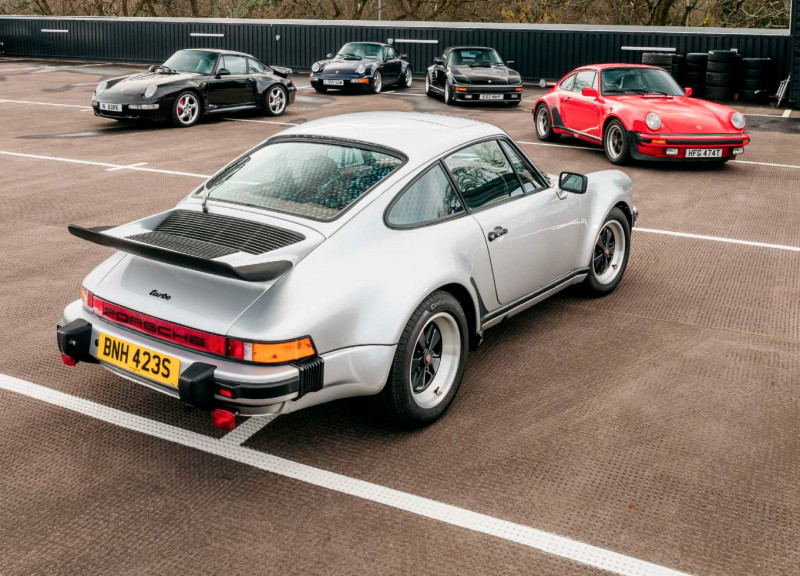
In recent years, ‘A’ to ‘F’ Series cars – particularly the 1973 RS – have been put on a pedestal. They were, it seemed, what every restomod 911 aspired to be. However, the arrival of Singer’s sensational Turbo Study, which reimagines the 930 in all its rubber-bumpered, whaletailed glory, suggests the classic Turbo is ripe for reappraisal. With help from Porsche collector, Nigel Gore, plus the Classic team at Porsche Bournemouth, that’s exactly what we have planned.
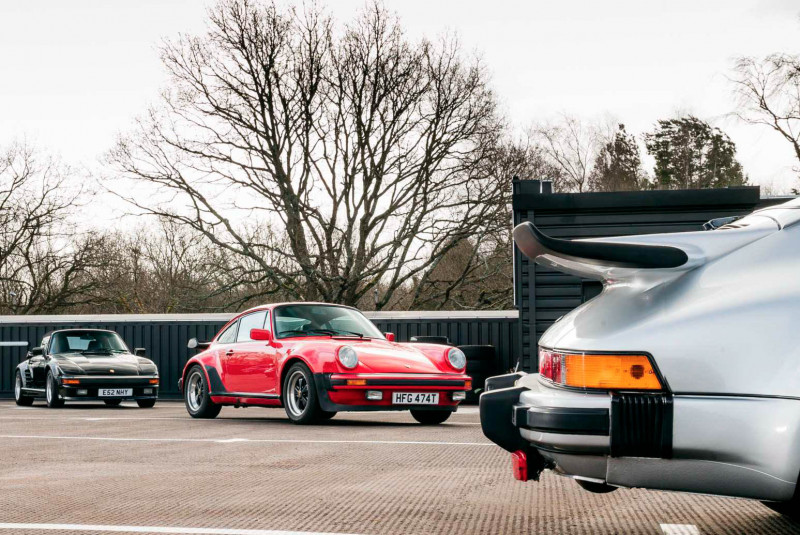
The five cars assembled here represent the evolution of the air-cooled Turbo, each one more potent and capable than the last. There’s a rare 930 3.0, its 3.3-litre successor – in Guards red, just like my childhood poster – an outrageous 930 SE Cabriolet and a brawny 964 3.6. A 993 Turbo with the X50 Powerkit serves as a final flourish. That wide-eyed schoolboy wouldn’t have believed his luck.
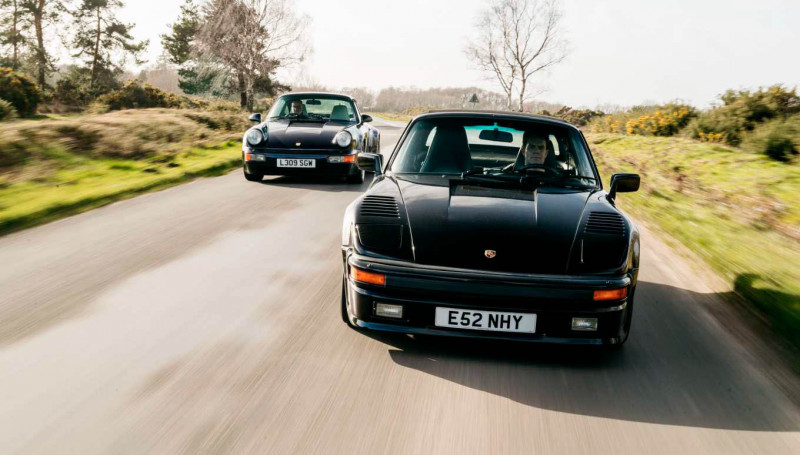
The Turbo has become a mainstay of the 911 range, but rewind to the early 1970s and its trajectory certainly wasn’t set. The prototype was a strippedout road racer, with a 2.7-litre engine inside the wider body of a 3.0 RS. Porsche initially planned just 200 cars for homologation purposes, but the marketing department had other ideas. By the time the production 930 reached the 1974 Paris Motor Show, the Turbo had transformed into a plush super-GT. Standard equipment included air-conditioning, electric windows, a four-speaker stereo and a rear wiper.
With a KKK turbocharger and 0.8 bar of boost, the original 3.0-litre 930 serves up 260hp – scarcely more than a new Golf GTI, and just 40 per cent of what a 992 Turbo S can muster. Yet even today it looks like the fastest thing on the road. Its shape isn’t voluptuous and feminine like the supercars of the 60s, or angular and sci-fi like the wedge-shaped exotics that followed. Instead, it’s a 911 on steroids, a factory hot-rod pumped up for performance. Seriously, what could be cooler?
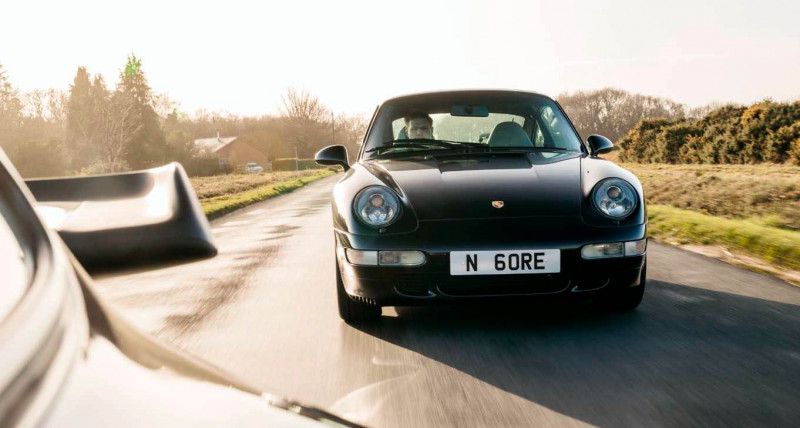
The inside of Nigel Gore’s metallic silver car is more of an acquired taste, with brown leather and pinstriped orange trim. It’s so 1977, I half-expect to see a pair of furry dice dangling from the mirror. The three-spoke steering wheel (another part recently reworked by Singer) looks fantastic, but the soft seats offer little side-support and the driving position is oddly upright for a sports car. You feel as though you’re sitting on top of the 911 rather than within it, peering down over those familiar front wings.
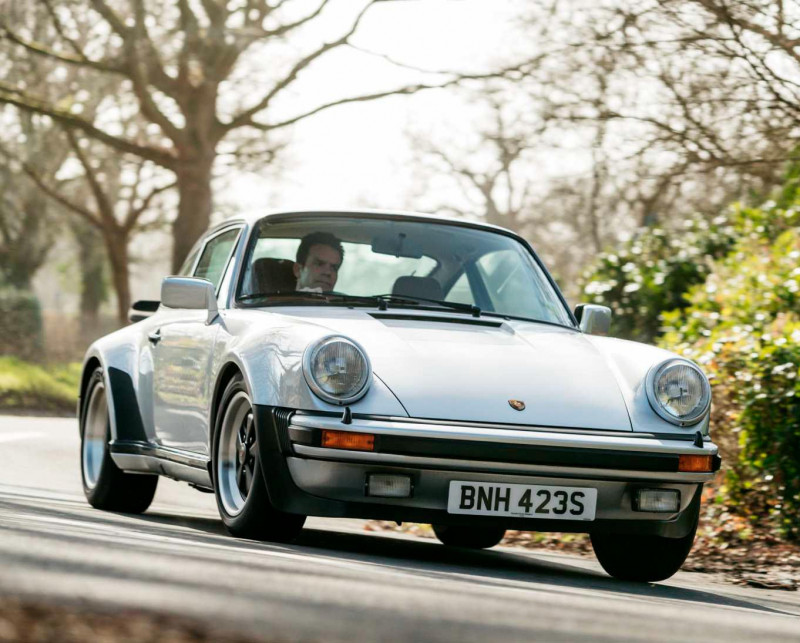
This is the only air-cooled Turbo that doesn’t hide its engine under a huge slab of intercooler – and I’d swear it’s louder as a result. The flat six sounds breathy, urgent and entirely mechanical, the commotion overlaid by a distinct hiss when the turbocharger wakes up. That frontier is crossed at 3,500rpm, and while the rush of forced induction isn’t as head-spinning as it surely was 45 years ago, the classic 930 still has a startling turn of pace. With a perfect launch, 0-62mph takes just 5.5 seconds. You need to keep it on the boil, though. With only four gears and a long-throw 930 gearbox, it’s easy to drop below the boost zone. Do so mid-corner and the 930 may deliver on its spiky reputation, snapping into oversteer that takes quick hands and a cool head to correct. It’s a car that demands forethought and rarely lets you totally relax – and that is, of course, part of its enduring appeal.
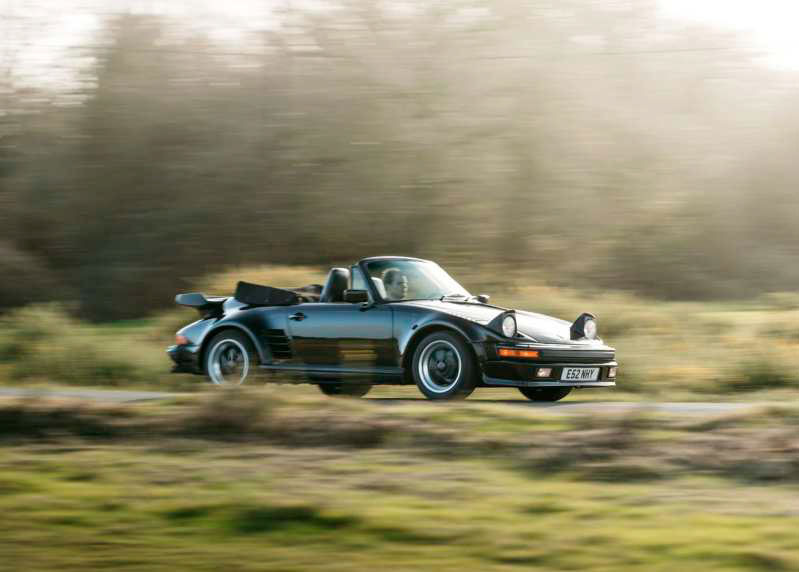
After three years in production, a major update for the Turbo came in 1978. The air-cooled engine grew by 305cc and 40hp, for a total of 300hp at 5,500rpm. This shaved the 0-62mph dash to 5.4 seconds, while beefed-up 917 brakes and a tweaked chassis helped to tame the Turbo’s wild side. The 911 SC gained five speeds that same year, but the 930 soldiered on with four ratios, its 412Nm of torque reportedly too much for the updated 915 transmission to handle. Not until 1989, its final year on sale, would the 930 enjoy a fifth gear.
Park the 3.3 alongside the 3.0 and the most obvious difference is the enlarged ‘tea tray’ spoiler, required to feed air to the intercooler. Look closely and you’ll spot the new headlight washers, which are no longer on insectoid stalks, and the boost gauge that reads to a more realistic 1.0 bar (1.5 bar in the earlier car). The dished Fuchs alloys also grew an inch in diameter, helping to fill out the 930’s flared arches, although this 3.0 has subsequently been fitted with the larger 16-inch rims.
I’m itching to get behind the wheel, but the demands of photography mean there’s only time to sample one of the 3.3-litre cars. And who could resist the chance to drive a genuine 930 SE? Like the Turbo itself, the SE’s roots are in racing. Its distinctive profile was inspired by the 935 (a contraction of ‘Group 5 930’), which had a flachbau nose designed by Norbert Singer to improve the 911’s aerodynamics. Porsche tuners such as DP Motorsport and Kremer soon copied the flatnose look, but the story of the official 930 SE starts with Mansour Ojjeh. A key player in Porsche’s return to F1 in the 1980s, Mansour commissioned the Sonderwunsch department to build a road-legal ‘935 Street’. This was tuned to 380hp and featured a bi-plane wing, slabsided wheel arches and steamroller 345-section rear tyres. After more requests for 935-style conversions, the official 930 SE followed in 1986.
For this child of the 1980s, the flatnose evokes excess-all-areas modified specials such as the Gemballa Avalanche – perhaps even more vividly than Porsche’s Le Mans-winning 911 racers. Glinting in the stark winter sunshine, its black bodywork is peppered with cooling vents, and accessorised with chunky side skirts and quad tailpipes. A larger turbo and extra oil cooler help lift output to 330hp: good for 0-62mph in 4.6 seconds.
Climbing aboard, the first thing I notice is the improved driving position. You sit lower than in the 3.0, secured in place by bigger bolsters, while the leather seats have electric adjustment. The roof of this Cabriolet model is electric, too. It retracts in just a few seconds, although you need to attach the fiddly tonneau cover by hand. Insert the trad-1980s immobiliser, twist the key and the engine fires with a brusque bark. It sounds gruff and busy, although more civilised than the silver car.
On the road, the SE’s gearshift is more positive and its extra 70hp is immediately apparent, with a surge of turbocharged shove that borders on violent. Its unassisted steering is hard work at low speeds and easily deflected on uneven roads, but the payoff is a constant sense of communication. You sense the rear end squat and the tyres dig into the tarmac, the four-spoke wheel always restless in your hands. This assault on your senses is further heightened by driving al fresco. With the roof down and headlights popped up, I’ve never seen a 911 turn so many heads. The next Turbo arguably looks even more exciting, though. To my eyes, the stretched proportions and ultra-squat stance of the 964 are a little cartoonish, but plenty of people – including Chris Harris of Top Gear fame – consider this the best-looking 911 of all. Rolling on the same polished 18-inch Speedline alloys as the 964 3.8 RS, it looks like a square-jawed action hero. The connection to a certain big-budget Hollywood movie (you know the one) seems very apt.
The 964 Turbo was first launched in 1990, with a reworked version of the 930’s 3.3-litre engine that produced 320hp. It took a further three years for the 3.6 Turbo to arrive, using the same 7.5:1 compression ratio and camshafts from the 3.3 Turbo S. The result was 360hp and 0-62mph in 4.8 seconds. Quick enough to drag-race a Shelby Cobra, apparently. Porsche’s original plan was to replace the 930 Turbo with a sub-959 supercar called the 965. Eventually killed by the accountants, this could have boasted air suspension, four-wheel drive and PDK – some 15 years before a dual-clutch gearbox debuted on the 911. By comparison, the 3.6 Turbo was defiantly old-school, with Bosch K-Jetronic injection (the 964 Carrera used a Bosch Motronic ECU), a single turbo and rear-drive. The last of the old guard, it wouldn’t be leaving quietly.
Slide behind the ugly air-bagged wheel and the swinging boost gauge is replaced by an LCD display, while the stubby gear lever has five ratios marked on the top. Sitting with both arms and legs skewed slightly to the left (Nigel’s car is one of only 159 right-hand-drive 3.6 Turbos), the 964’s fulsome hindquarters fill the teardrop-shaped Cup mirrors. Its engine idles more smoothly than the 930, with a deep menacing throb from the twin exhausts.
On the coarse and crumbling tarmac of the New Forest, the 964 reveals itself as a car of contrasts. The clutch, gearshift and power-assisted steering are all lighter than its predecessor, and the latter filters out much of the 930’s fidgety white noise. However, the chassis as a whole seems less suited to British B-roads; a wide track and stiffer suspension making it feel a little skittish. The limits of the 265-section rear tyres are high, but the transition from understeer to oversteer isn’t subtle.
That said, the 964’s party-trick is worth the price of admission alone. The turbo starts to spool at around 2,700rpm, then by 3,500rpm all hell is unleashed. It feels like going into freefall, a sustained rush that literally takes your breath away. The 911 accelerates like a lit firework, hitting 62mph in 4.8 seconds. Even writing this, days later, I’m still smiling at the madness of it.
The final classic Turbo almost acts as a cool-down exercise after the intense, all-guns-blazing 964. Yet the 993 is also the quickest car here, particularly with the optional X50 Powerkit. This included an oil cooler, remapped ECU and freer-flowing exhaust system for 430hp – half-way between the ‘standard’ 409hp Turbo and the last-hurrah 450hp Turbo S. With viscous-coupled four-wheel drive from the Carrera 4, the 0-62mph sprint takes 3.7 seconds. In some ways, the 993 came good on the ‘junior 959’ project, introducing technology such as a dynamic limited-slip diff and twin turbos (albeit one per cylinder bank, rather than a sequential setup) to the air-cooled 911 platform. Its bar-of-soap styling also bears some resemblance to the 1986 supercar, while the snug interior will still feel familiar to owners of classic 911s – unlike the clean-sheet 996 that followed. As a driving experience, though, the 993 very much aligns itself with the 21st century Turbo: a civilised and devastatingly effective all-weather performance car. The second turbo eliminates the all-or- nothing lag of the 964, and 4WD (which diverts up to 40 per cent of torque to the front wheels) means tenacious traction out of corners. There’s even a sixth ratio for the manual gearbox.
Twenty-six years after launch, the 993 Turbo remains a car with huge bandwidth – and one you could drive every day. The richly organic steering is the best of any 911 here and the damping offers an extra layer of silken sophistication. Hugged by shapelier bucket seats, with a hit of turbocharged torque always at the ready, you feel instinctively more able to exploit its abilities. I longed to spend more time with it, but the light was fading and we needed to head home.
These five 911 Turbos are all so different that, ideally, you’d follow Nigel’s example and have one of each. However, a group test demands a winner – and that car is the 930 3.0 Turbo. Its place in Porsche history is assured, and it still can’t be trumped for sheer sense of occasion. Wherever the 911 Turbo goes next, this is where it all started.
THANKS The stunning air-cooled Turbos in our feature were supplied by Nigel Gore. Thanks also to Porsche Centre Bournemouth for helping Team T911 with the photoshoot
TECHNICAL DATA
- Model 1997 Porsche 911 Turbo X50 993
- Year 1997
- Engine Capacity 3,600cc
- Compression ratio 8.0:1
- Maximum power 430bhp @ 5,750rpm
- Maximum torque 585Nm @ 4,500rpm
- Transmission Six-speed manual
- Suspension Front MacPherson struts, transverse arms, coil springs Rear Multi-link LSA axle
- Wheels and tyres
- Front 8x18-inch; 225/40/ZR18
- Rear 10x18-inch; 285/30/ZR18
- Dimensions
- Length 4,245mm
- Width 1,795mm
- Weight 1,500kg
- Performance 0-62mph 3.7 seconds
- Top speed 188mph
ABOVE This 964 3.6 Turbo is only one of 159 right-hand drive models produced
ABOVE The ‘Flachbau’ 930 was born in Porsche’s Sonderwunsch department, and oozes ’80s excess
- Model 1987 Porsche 911 Turbo SE Cabriolet 930
- Year 1987
- Engine Capacity 3,299cc
- Compression ratio 7.0:1
- Maximum power 330hp @ 5,500rpm
- Maximum torque 432Nm @ 4,000rpm
- Transmission Four-speed manual
- Suspension Front MacPherson struts, lower wishbones, longitudinal torsion bars Rear Semi-trailing arms, lateral torsion bars
- Wheels and tyres
- Front 7x16-inch; 205/55/VR16
- Rear 9x16-inch; 245/45/VR16
- Dimensions
- Length 4,291mm
- Width 1,775mm
- Weight 1,550kg (estimated)
- Performance 0-62mph 4.3 seconds
- Top speed 173mph
TECHNICAL DATA
- Model 1993 Porsche 911 Turbo 3.6 964
- Year 1993
- Engine Capacity 3,600cc
- Compression ratio 7.5:1
- Maximum power 360hp @ 5,500rpm
- Maximum torque 520Nm @ 4,200rpm
- Transmission Five-speed manual
- Suspension Front MacPherson struts, transverse arms, coil springs Rear Semi-trailing arms, coil springs
- Wheels and tyres
- Front 8x18-inch; 225/40/ZR18
- Rear 10x18-inch; 265/35/ZR18
- Dimensions
- Length 4,250mm
- Width 1,775mm
- Weight 1,470kg
- Performance 0-62mph 4.8 seconds
- Top speed 174mph
ABOVE The ‘Flachbau’ 930 was born in Porsche’s Sonderwunsch department, and oozes ’80s excess.
ABOVE LEFT The 3.3 heralded use of an intercooler for the first time, necessitating a change in spoiler profile to a ‘tea tray’.
ABOVE The driving position of the 930 3.3 SE is an improvement over that of the original 930 3.0
“Rolling on the same polished 18-inch Speedline alloys as the 964 3.8 RS, it looks like an action hero”
TECHNICAL DATA
- Model 1980 Porsche 911 Turbo 3.3 930
- Year 1980
- Engine Capacity 3,299cc
- Compression ratio 7.0:1
- Maximum power 300hp @ 5,500rpm
- Maximum torque 412Nm @ 4,000rpm
- Transmission Four-speed manual
- Suspension Front MacPherson struts, lower wishbones, longitudinal-torsion bars Rear Semi-trailing arms, lateral-torsion bars
- Wheels and tyres
- Front 7x16-inch; 205/55/VR16
- Rear 8x16-inch; 225/50/VR16
- Dimensions
- Length 4,291mm
- Width 1,775mm
- Weight 1,335kg
- Performance 0-62mph 5.4 seconds
- Top speed 161mph
“This is the only air-cooled Turbo that doesn’t hide its engine under a huge slab of intercooler – and I’d swear it’s louder as a result”
LEFT The 930’s non-intercooled 3.0-litre engine means the noise of the working turbo is even more apparent
TECHNICAL DATA
- Model 1977 Porsche 911 Turbo 3.0 930
- Year 1977
- Engine Capacity 2,994cc
- Compression ratio 6.5:1
- Maximum power 260hp @ 5,500rpm
- Maximum torque 343Nm @ 4,000rpm
- Transmission Four-speed manual
- Suspension Front MacPherson struts, lower wishbones, longitudinal torsion bars Rear Semi-trailing arms, lateral torsion bars
- Wheels and tyres
- Front 7x15-inch; 185/70/VR15
- Rear 8x15-inch; 215/60/VR15
- Dimensions
- Length 4,291mm
- Width 1,775mm
- Weight 1,140kg
- Performance 0-62mph 5.5 seconds
- Top speed 155mph


